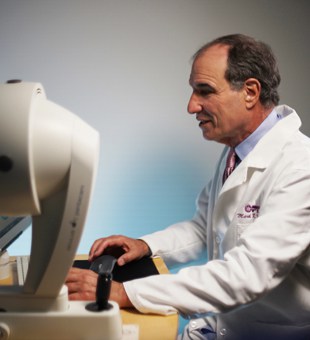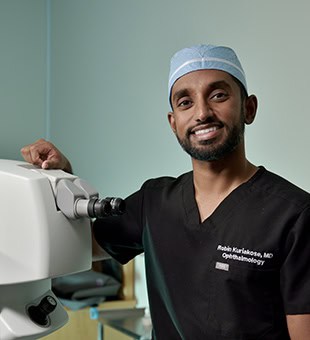Offices in Hayward, Castro Valley & San Jose
The LASIK alternative …PRK, …is known as a “surface procedure.” The LASIK alternative procedure of choice is PRK. PRK is performed for patients who are not good candidates for the LASIK procedure and for the occasional patient who would otherwise be a good candidate for LASIK, but requests an alternative instead. The main indication for a LASIK-alternative procedure is a cornea which is too thin to safely undergo a LASIK flap, or a cornea with relatively normal thickness but which has a mildly abnormal configuration such that it may not be safe to perform LASIK. Additionally, some patients in high-risk occupations or with high-risk hobbies where they are likely to incur a physical eye injury with potential damage to the flap, may be better suited for PRK.
Procedure Overview
For PRK , the excimer laser is programmed the same as for the LASIK procedure, but because the laser is applied directly to the surface of the cornea, there can be no flap complications such as microfolds, or intra-operative or post-operative flap trauma. The disadvantage of this is that it may take up to 4 weeks for the patient’s vision to become clear. Therefore, unlike LASIK, most patients elect to have PRK in just one eye at a time. A corrective contact lens is worn in the unoperated eye until the vision is clear enough in the operated eye and then the second eye undergoes surgery. This is typically 3 to 5 weeks after the first eye. If a patient does not wear contact lenses, then the unoperated eye can be corrected with a spectacle lens while clear glass can be placed in the spectacle over the operated eye during the healing process.
Associated Risks
Most of the risks and complications of the PRK procedures are the same as for the LASIK procedure. Therefore, patients must view Dr. Mandel’s web video on this website and read the outlines on the complications on LASIK prior to undergoing PRK. The additional complication that can occur following PRK, but not in LASIK patients, is the potential for scarring on the surface of the cornea. This scarring, if left untreated, can significantly decrease visual acuity and quality of the vision. It may also induce regression back toward nearsightedness and/or astigmatism.
Possibility of Scarring
In order to diminish the possibility of scarring, your surgeon has been performing PRK with the intra-operative use of Mitomycin-C. Although not FDA approved for this procedure, it is common and standard practice among experienced refractive surgeons. Mitomycin-C is a cancer chemotherapeutic agent, which, in this case, is used to prevent scarring of the surface of the cornea following PRK. We have not observed nor are we aware of any complications that result from the off-label use of intra-operative Mitomycin-C in the concentrations and for the time periods for which we use it in refractive surgery.
Post-Operative Enhancement
Like all corneal refractive procedures, after PRK a certain percentage of patients require an enhancement for overcorrection, under correction, or induced astigmatism. Your probability of needing an enhancement is based on many factors such as your degree of nearsightedness, farsightedness and/or astigmatism, as well as individual healing factors that cannot be predicted. If you require an enhancement, this is usually performed 6 to 8 months after your initial PRK procedure to ensure that the refraction is stable. If an enhancement is required, a repeat PRK with Mitomycin-C will be performed.
Complications
Haze and/or scarring of the surface of the cornea may occur following PRK. However, it is rare with lower degrees of nearsightedness (less than 5.00 diopters). In all patients undergoing PRK I briefly place a small sterile sponge with a medication called Mitomycin-C on the surface of the treated cornea. This substantially decreases the chances for scarring or haze following PRK. However, if scarring occurs, it can permanently decrease vision. This occurs in less than 0.5% of cases in our hands.
About 13% of LASIK or PRK patients may require a retreatment (enhancement or touch-up) for undercorrection, overcorrection and/or induced astigmatism. Retreatment is more common in patients who are highly myopic, highly hyperopic, or who have a lot of astigmatism. With either PRK or LASIK regression and undercorrection is very uncommon with less than 3.00 diopters of myopia or hyperopia, or 2.00 diopters of astigmatism.
Irregular astigmatism (i.e., a “wavy” corneal surface) due to decentration of the laser optical zone or uneven healing is uncommon with both procedures (less than 1%).
Loss of best correctable (i.e. with glasses) vision worse than two lines on the vision chart is about 0.5% to 2% for both LASIK and PRK.
Recurrent corneal erosions are uncommon with both PRK and LASIK.
Infections are very rare, but may result in permanent loss of vision. Sterile inflammatory white blood cell infiltrates in the treated area occur rarely in surface PRK while wearing the therapeutic bandage soft contact lens. These usually respond well to treatment with topical antibiotics and cortisone. Sterile white blood cell infiltrates (DLK) below the flap can also be seen with LASIK.
Cortisone-induced glaucoma
Unlike LASIK, many PRK patients require topical cortisone for 1 to 4 months to reduce scarring and prevent regression. A small percentage of patients have a genetic tendency to develop high pressure in the eye when given cortisone topically for this long. When the cortisone drops are discontinued, the elevated pressure in the eye generally returns to normal. Rarely does the pressure remain elevated and require treatment. LASIK patients use cortisone drops for a few days and cannot develop cortisone-induced glaucoma. Cortisone can also cause cataracts, but fortunately they are rarely seen with four months or less of topical therapy. The rare patient may develop an early cataract requiring cessation of cortisone, at which time the cataract usually stops growing. LASIK patients use cortisone drops for only a few days and cannot develop cortisone-induced cataracts.
Learn More About PRK
Your surgeons at the team at OPTIMA Eye, are committed to helping their patients achieve the quality vision they deserve. They offer PRK as an option for patients who do not qualify for LASIK surgery. To learn more about these procedures, or to schedule a consultation, contact OPTIMA today at 510-886-3937




